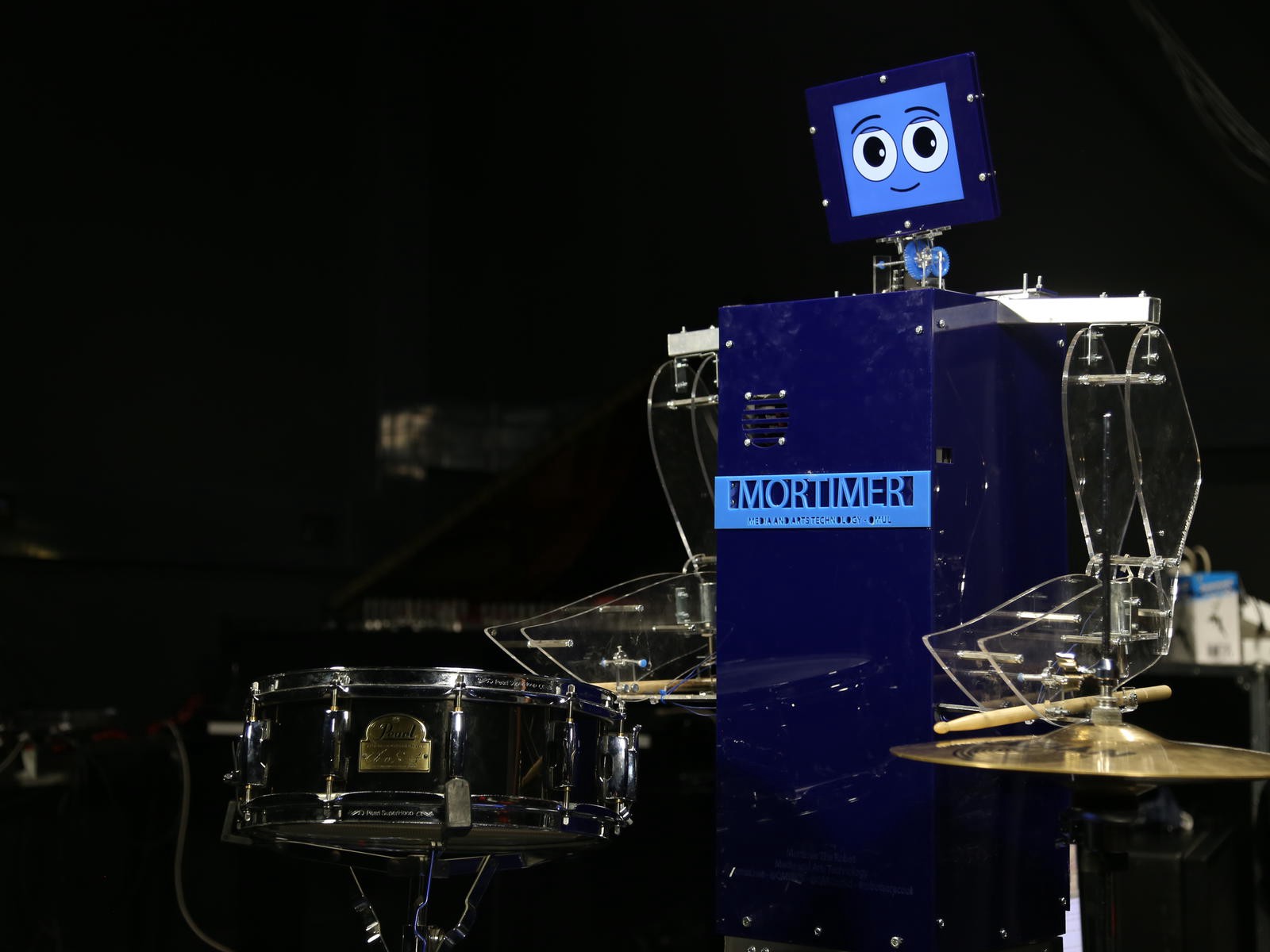

For his Ph.D., Louis McCallum built himself a robot drummer. Before I have a chance to ask why, the drummer in question, Mortimer, interjects with that sort of slow, robot voice that seems to be composed of a series of well-organized beeb noises.
“Good. Golly! OK. I. Will. Count. You. In. One. Bar. Are. You. Ready? Rock. And. Roll!”
Mortimer is blue and boxy, with big eyes that blink every now and again, slightly disconcertingly. We’re in a small music studio at Queen Mary, University of London. The robot is placed in front of a small drum kit. His maker sits by a keyboard.
McCallum and Mortimer play together for a few minutes. They are jamming, I suppose. But it is deeply serious, and the monotony of the robot voice that’d exclaimed, “Good. Golly!” is now reflected by the steady beat of drums. Something about it feels a bit sad. Though it’s fun, too, in its own way.
McCallum stops. Mortimer follows him, and reassuringly adds, “It. Doesn’t. Matter. These. Things. Happen.”
He’s programmed to give positive support when people quit, McCallum explains. “But sometimes it sounds a bit passive aggressive,” he adds with a grin.
It all feels a bit weird, but it’s this weirdness that the project hopes to help us unpick. Mortimer’s less a means for making music and more a tool to study how people interact with artificial personalities in social contexts, an exercise in exploring human-robot interaction.
Robots often work in environments where there aren’t any humans (car factories, Mars, etc.), McCallum explains. But increasingly this isn’t the case, and we can feel anxious or, at least, a bit awkward around them–even if we also find them exciting and fun. If we’re going to have robots living alongside us, we’re going to need to relax. Gaining a more advanced understanding of social robotics could help us get there. The research project “is basically how not to make it weird,” McCallum says.
Mortimer is McCallum’s mother’s maiden name. He wanted to give the robot an actual name, not a clunky acronym, nor an “i” at the beginning or “bot” at the end. “Putting bot at the end is the worst,” he groans. Still, Mortimer is deliberately designed to look robotic. McCallum thinks that robots made to look too human are a bit sinister.

One problem associated with studying how humans interact with artificial personalities is that humans can get bored quite quickly. The idea of Mortimer, the robot drummer, is to offer an activity as a foundation to keep people in engaged. Whereas similar research is often based on one-off studies, McCallum’s project has people come in once a week for two months. It lets them get over the initial feeling of, “Ooo, cool, it’s a robot,” and explores how relationships can change and develop over time.
At first the robot didn’t talk, or blink. The music was engaging enough to offer an interaction, but then McCallum added a face and expressions; that seemed to have impact. All the research subjects were asked to stay for a minimum of 10 minutes, and after that as long as they liked. Those in the group where the robot had facial expressions stayed for more time.
Over the course of the study, as the humans became accustomed to Mortimer, the researchers found that subjects opted to hang out longer. They also found that people interrupted Mortimer less as the study went on. You might expect people to skip ahead when they know what a robot is going to say–like pressing next on a website or skipping the start of a game–but a sense of politeness or something similar seemed to kick in, like a relationship of sorts had been built.
McCallum is nearing the end of his Ph.D. and hopes the research will feed into our understanding of human-robot interactions. As for Mortimer? He’s already performed with the Festival of the Spoken Nerd and, this week, will feature in the Royal Institution’s world-famous Christmas lectures. The otherness of robots can have a glamour to it, even if it can also feel expectedly strange at times.


How We Get To Next was a magazine that explored the future of science, technology, and culture from 2014 to 2019. This article is part of our Fast Forward section, which examines the relationship between music and innovation. Click the logo to read more.
